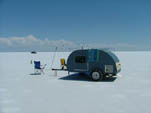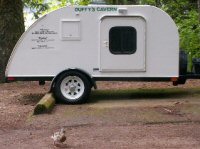Mike,
I was once lucky enough to sit through a 2 hour lecture by "Bucky" Fuller, the guy who invented the geodesic dome, among other things.
He was adamant that the value and cost of a structure was related to it's weight.
He insited that extremely light structures could be made, but that the fasteners had to be accurately installed. If the hole was a lot bigger than the bolt, the potential problem was greater than if the hole was the exact size of the bolt.
Mercedes in Germany had a project to prove that light cars can be safe. I am still convinced we are building tears inspired by the 1930's.
With your little tow rig, what kind of problem are you going to get into? Keep the tear very light, give it plenty of clearance on a decent suspension and have a ball.
That's my nickel.
dave
Re: Light weight & off-road?
angib wrote:There are no racking forces on a trailer, because they sit on three points (two wheels + hitch) so they can't get twisted like a four-wheeler. There are some small inertia loads that will twist a trailer a little, but the lighter you build, the smaller those loads are.
Andrew
Hey guys I know it has been a while since I've spent much time on here but I guess I'll have to blame it on project related ADD.
Well, I thought I would update this thread a little.
First, I would still like to build the tear that I described in my first post but it will probably take me quite a while to get it done.
Second, I saw something the other day that made me question Andrew's explanation that there were no racking forces on a trailer. I was in town at a stop light behind a truck pulling an all aluminum stock (cattle) trailer. The thing that cought my eye was that the rear upper corners of the trailer had both been welded up to repair sections where the trailer had torn itself apart.
I also checked my copy of "Trailers - How to Build & Design Volume 2 - Structure" by M.M. Smith and found an interesting discussion in the first chapter about torsion loads. The following are some parts that I am quoting from page 7 of this book.
"With a trailer, twisting of the frame or axle may occur when one wheel of the trailer goes over a bump and the other wheel does not. If the load is heavier on one side or corner bump loads are applied unevenly, torsion can occur. Just bouncing down the road can apply loads which result in twisting of the frame.
"The use of tubing or diagonal bracings in strategic places as well as special shapes can help to resist some of these wayward forces."
And from page 8:
"A stiff frame, stiff corners and a stiff rear door frame can help appreciably toward resisting the twist as can well designed shear panels which transfer load effectively from one frame member to the next."
This torsion or twisting force that Mr. M.M. Smith is talking about is what I refer to as a racking force. I may be using the term incorrectly but according to this it seems to me that racking is a force that is present and needs to be designed for when building a trailer of the style that I described.
What are your thoughts guys?
Mike Olsen - Rexburg, ID :^)
-

M. Olsen - Teardrop Master
- Posts: 111
- Images: 77
- Joined: Thu Apr 22, 2004 12:03 am
- Location: Idaho, Rexburg

